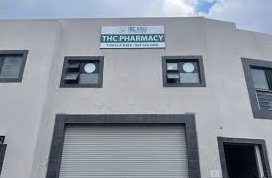One of those stories that makes one wonder about the sanity of our world.
Firstly we will start with a definition as they never have 5th degree felonies on all those endless cop or law firm shows we consume daily here at CLR !
Minnesota Fifth Degree Controlled Substance Offenses. Fifth degree possession or sale of a controlled substance is a serious criminal offense in Minnesota. … As a felony–level drug offense, fifth degree possession or sale of is punishable by up to five years in prison and a $10,000 fine.
Capital Journal reports
Phil Reed, first-year owner of Root River Gardens, a hemp farm nestled in the bluffs of the Root River Valley near Lanesboro, Minn., said if it weren’t for his consultant, the operation wouldn’t be possible.
Reed’s consultant is Luis “Lulu Magoo” Hummel, who still faces criminal charges in Fillmore County District Court of fifth-degree drug sales, felony possession of a controlled substance and gross misdemeanor fifth-degree drug. Seized items from Hummel’s farm were tested and found to have over the 0.3 percent THC level, which is the psychoactive part of cannabis. A jury trial is scheduled to begin on Jan. 26 for those charges.
Reed said they began to harvest in the first week of October and wrapped up in about two weeks. Hemp is a “challenging grow” that’s not for everybody, said Reed.
“We’ve got most of the good stuff out of the field already, and are basically just chopping plants now to take in and hang,” Reed said on Oct. 16.
He said the hemp plants were put in the ground a little late this year, in May, but usually they would plant in April. Despite the late planting, Reed said it was a “good year” for Root River Gardens.
“The weather was good, and we had the right amount of moisture,” Reed said of the growing season.
The slope that Root River Gardens grows its hemp on helps the plants avoid any moisture issues, Reed said.
Reed called his first year as a hemp grower an “awesome experience.”
“It’s a lot of work, because growing hemp takes a lot of hands-on work with the way we do it,” Reed said. “Especially outdoors like this, there’s a lot of effort that has to go into it.”
He said fortunately for him he’s been guided by Hummel, who has helped him out “really big.” Reed said without a good consultant, he’d “never make it” as a first-year hemp grower.
“Get the right help,” Reed said to prospective hemp growers. “If you’re interested in going into (hemp farming), you’ve got to contact the right people.”
He said through Hummel, Root River Gardens has the right people and “friends in the business” to make it a worthwhile operation.
As far as getting the hemp from the fields of Lanesboro to the consumers of CBD, Reed said Root River Gardens relies on a lot of direct and wholesale sales.
“If you’re getting into this business you want to make sure you have a place to get rid of your product at some point, and know what those values are,” Reed said.
To have hemp made into another product requires processing, for which Reed said Root River Gardens has a couple of partners.
According to Margaret Wiatrowski, program coordinator for the Industrial Hemp Program with the Minnesota Department of Agriculture, there were 580 hemp licenses issued this year. That number includes both hemp growers and processors.
“We definitely saw a lot of people’s plans get scaled way back because of COVID,” Wiatrowski said. “That is a trend not just in Minnesota but nationwide, which could end up being a good thing for these markets, because maybe there isn’t as much material hitting the market during harvest time.”
An MDA inspector must sample each hemp lot produced in Minnesota, and the lots are sampled within 30 days of harvest, said Wiatrowski. Samples are then sent to a lab to be tested for THC levels.
“We’re wrapping up our inspections now, especially because of the early winter,” Wiatrowski said on Oct. 20. “The bulk of our inspections were done in August and September.”
Wiatrowski said over 700 samples had been collected by MDA inspectors this year, and estimated between 5-10% of the samples had failed THC threshold testing.
“It’s a relatively small number but not totally insignificant,” she said. “But it is a lower failure rate than what we saw last year.”
In 2019 there was a 12% failure rate of the THC tests, she said.
Root River Gardens gets its name from the South Fork of the Root River, which flows through Lanesboro and includes a waterfall dam. Hummel met the landowners he’s rented the land from while bartending in Lanesboro, and planted 1.5 acres of hemp under the state’s pilot program in 2018.
“I’ve been in the forefront of some of the industry’s problems and misunderstandings, but all in all we’re moving forward with the operations,” Hummel said.
After being charged in Fillmore County, Hummel felt that state officials had forced him to destroy his crop without due process or clear rules in the industry. The Minnesota Department of Agriculture notified Hummel via letter that his license was revoked and his crop needed to be destroyed.
Alleging that his constitutional rights were violated, Hummel and his company, 5th Sun Gardens LLC, filed a civil suit in U.S. District Court of Minnesota last spring against the Minnesota Department of Agriculture, its commissioner and three named officials as well as two unnamed individuals.
Last February, Hummel, through attorney Jason Tarasek, filed a motion to dismiss the case after reaching an out-of-court settlement with the Department of Agriculture.
According to the settlement, Hummel will not seek to recover attorney fees and has waived his right to a hearing on his license revocation. He also agreed that he will not apply for a Minnesota Industrial Hemp License in 2020 or anytime after. Growing hemp again was something Hummel was willing to give up, according to Tarasek.
Minnesota Department of Agriculture senior communications officer Allen Sommerfeld said at the time that the MDA agreed to allow someone else to grow hemp on land owned by Hummel as long as that person meets all the licensing requirements.
On top of consulting, Hummel said that he is now only doing retail and distribution business within the hemp and CBD industry.
“I can keep going forward (with his company 5th Sun Gardens) with marketing and branding, and working and partnering with other companies to create a quality product,” Hummel said.
Hummel said once more people understand that CBD is “not getting you stoned, but helping health and holistic properties,” he thinks hemp will be a booming industry in southern Minnesota. He believes it’s the “politics” holding back hemp from reaching its potential.
“We need to have our own lobbyists, and get people working for the small farmers and not necessarily just big ag,” Hummel said. “Give us a chance to show what we can do.”
Despite running into troubles with the law regarding his hemp business, Hummel felt the responsibility to stay in the community he became a part of in 2016 when he moved from a suburb of Chicago.
“There’s too much work that still needs to be done to keep moving this business forward; I can’t just stop now,” Hummel said. “If I have to have other people help on the growing side, that’s even better, because more people are getting involved and that’ll hopefully make a movement.”
Wiatrowski said she’s already curious about what the hemp program will look like in 2021.
“We’re already seeing a lot of interest from new growers, and our application period for next year doesn’t open until Nov. 1,” she said. “So we’re really gearing up for that.”
Supporting Article 3 January 2020
Hemp case reveals shortfalls in regulation, enforcement
PRESTON, Minn. – In the grey area of Minnesota’s industrial hemp industry is a Lanesboro hemp grower who is being painted as either a calculating drug dealer or an unlucky farmer.
Luis “Lulu Magoo” Hummel is charged in Fillmore County District Court with fifth-degree drug sales, felony possession of a controlled substance and gross misdemeanor fifth-degree drug possession.
The charges came after products derived from hemp on Hummel’s farm were seized in a March 15 traffic stop and tested above the acceptable 0.3 percent threshold for THC content.
Hummel was not in the car at the time of the stop, but the products came from hemp he was licensed by the Minnesota Department of Agriculture to sell.
If found guilty, Hummel will be forced out of an industry he’s said to be deeply passionate about. Under USDA guidelines now in place, a person with a state or federal felony conviction relating to a controlled substance is subject to a 10-year ineligibility restriction on producing hemp.
The case not only has implications for Hummel but could set a precedent for future decisions on industrial hemp. During a contested omnibus hearing in Fillmore County District Court on Dec. 17, witnesses from the MDA and Fillmore County Sheriff’s Office ended up shedding light on a system overwhelmed with regulations and untrained on enforcement.
CBD or marijuana?
On March 15, Deputy Alex Hartley of the Fillmore County Sheriff’s Office said he pulled over a vehicle for speeding in rural Ostrander. As he approached the window, Hartley said he noticed a smell consistent with marijuana coming from the car. When asked about the smell, the driver informed him it was coming from CBD products inside the vehicle.
Hartley said the man then voluntarily showed him each of the products, which were all labeled with Hummel’s business, 5th Sun Gardens. The driver even produced documentation from the department of agriculture, stating the products were derived from legal industrial hemp and where they were tested for THC content.
But to Hartley, who said he was never trained on industrial hemp, it appeared to be marijuana.
“I specifically remember opening one of the small round containers, and even on a windy day I could smell the odor that’s consistent with marijuana,” he said.
Unsure what to do, the deputy called and sent photos of the products to Jesse Grabau, Fillmore County narcotics investigator. Grabau advised Hartley to seize the items.
St. Paul defense attorney Susan Johnson, who’s representing Hummel, questioned Grabau on the witness stand.
“As the narcotics investigator with Fillmore County Sheriff’s Office,” how much training had he received on industrial hemp prior to March.
“No real training,” he said.
Grabau went so far as to recall a phone call he had with Hummel in April, in which he “probably” told Hummel there was “lots of grey area” on the issue of industrial hemp.
It was a mystery at first how they would test the products for THC content, said Grabau. The field tests they currently have cannot decipher between hemp and marijuana.
So he called the Bureau of Criminal Apprehension and talked to a scientist, who told him the BCA had no test for industrial hemp either. Grabau was told later by the MDA that he would need to take samples from each item and send them to Legend Technical Services in St. Paul-the only accredited lab in the state that the MDA works with.
A ‘rapidly evolving’ job
The first witness called by the defense during the hearing was Margaret Wiatrowski, coordinator of MDA’s industrial hemp program. Her testimony marked the first time the department had addressed Hummel’s case directly, and also revealed how MDA personnel were stretched thin before it became entirely overburdened by the growth of the program.
Wiatrowski has worked in the industrial hemp program for three years, two of which as its only full-time employee. She managed the application process, background checks, licenses, performed nearly every sample collection and was the main point of contact for the state’s licensed hemp growers.
Her job has been rapidly evolving since 2016, the first year of a pilot program, when there were six licensed growers who grew about 40 acres of hemp. Participation in the industrial hemp program increased by 27 growers in 2017, and then by 10 in 2018 to total 43 license-holders.
“This past year, there were about 380,” Wiatrowski said of licensed hemp growers.
That number doesn’t include the more than 150 hemp processors, who also need to gain licensing through the MDA.
The 2018 Farm Bill, which removed hemp as a controlled substance and ordered federal guidelines for U.S. hemp production, turned the gradual incline of the program to a launch.
The recent federal farm bill not only opened but held the door for commercial hemp growers to enter an untapped industry. It resulted in more than 700 license applications to the MDA, which is when Wiatrowski said it was fair to say the program “had exploded.”
Lacking manpower and money
Wiatrowski was the staff member who visited Hummel’s farm twice in 2018, once during growing season and again in August for an inspection of his crop.
Johnson entered several exhibits into evidence to prove that her client was properly licensed by the MDA in 2018. For each strain of hemp that passes a THC threshold test, growers are issued a Fit For Commerce certificate. Hummel was granted six certificates in 2018.
Then in March, Wiatrowski said she learned that vape tips and hemp dabs labeled 5th Sun Gardens were found to have a THC content of 3.59 and 3.11. She said it would have been impossible for Hummel to have already harvested his 2019 crop by then, meaning the products derived from his 2018 season.
Fillmore County Attorney Brett Corson, who during an earlier hearing called Hummel an “individual who knowingly manufactured and distributed drugs in the community,” asked Wiatrowski how his hemp could pass a THC threshold test in 2018 and then contain 10 times the allowable THC a year later, after it had been harvested?
She said a method of processing called decarboxylation is one possible explanation. Decarboxylation means to process THCa and CBDa in cannabis to active compounds of THC and CBD by using heat. The heat causes acid in the cannabinoids to drop a carbon dioxide molecule, changing the chemical formula from THCa to THC.
THC unknown
Wiatrowski explained the MDA’s process of taking samples for testing, in which samples are bagged, sealed and labeled by an MDA inspector before they are sent to St. Paul for testing. A cannabinoid profile analysis is then conducted and a final determination is made by the MDA based on the total potential THC post-decarboxylation.
Growers have 30 days to harvest their crop after its been sampled by the MDA (the USDA’s new ruling requires 15-days), because THC content increases in plants the longer they are in the ground.
Judge Matthew Opat then asked Wiatrowski how the MDA can be sure harvested plants don’t have higher THC content than what was claimed by the tested samples.
“It is an issue, and we know it’s an issue,” said Wiatrowski. “But we just don’t have the manpower or money to be doing follow-up testing.”
















